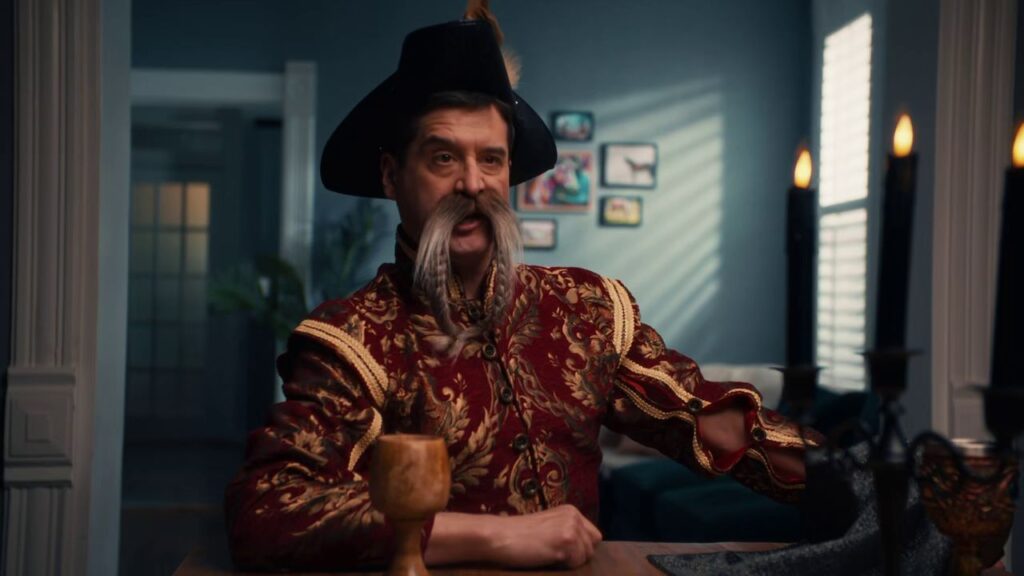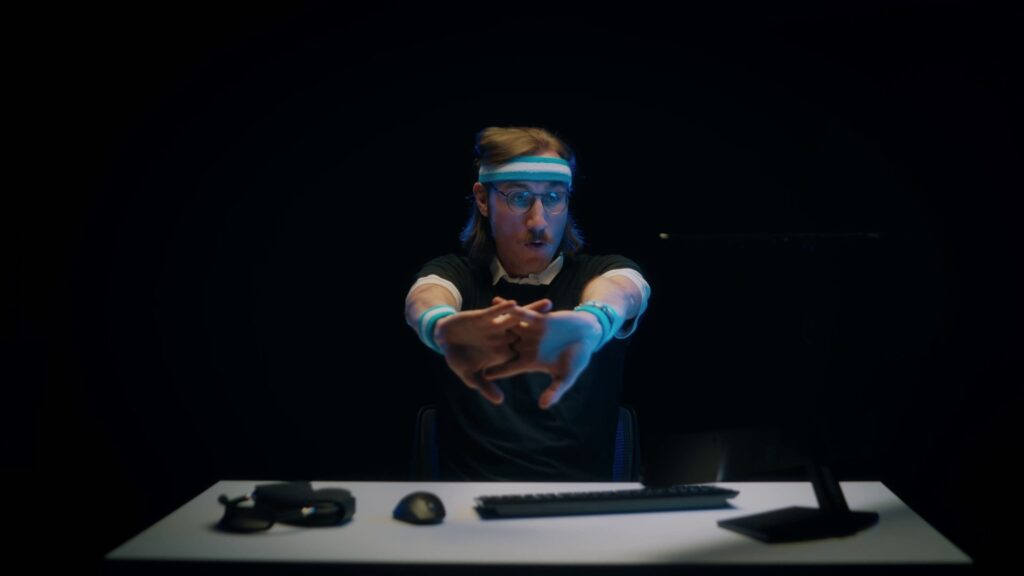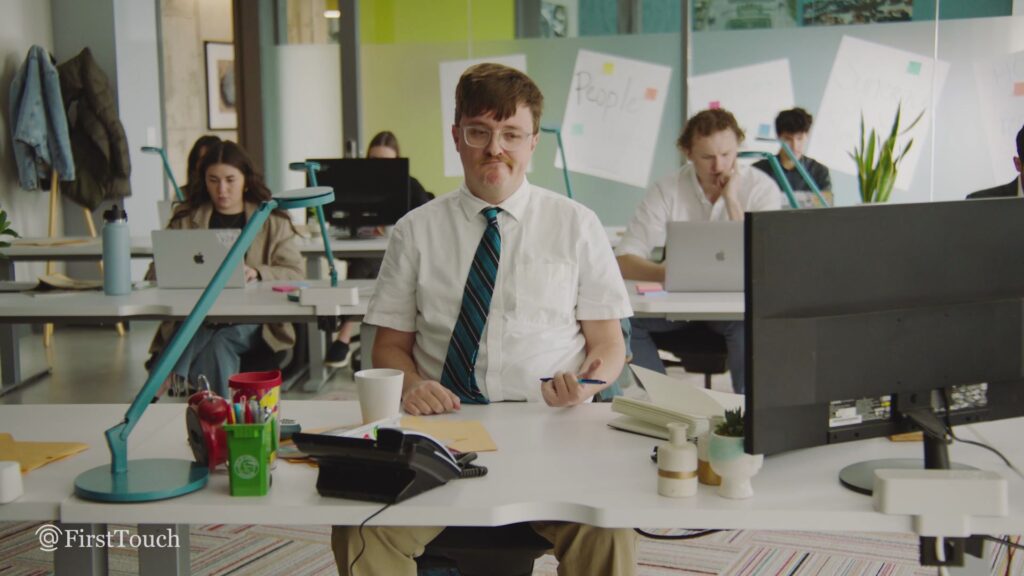case study: litehouse ranch
Directors Chad Neidt and Woody Roseland were approached by the marketing team at Litehouse Foods to create two engaging rap-themed 30-second commercial spots.
The goal of these light-hearted spots would be to highlight how Litehouse Ranch is the premiere condiment for game-time snacky finger foods.
The commercials first aired during Week 1 of the 2024 NFL football season.
commercials
client: Litehouse Ranch co-director: Woody Roseland
co-director: Chad Neidt 1st ad: Brian Bell
dp: Justin Balog 1st ac: Max Green
steadicam: Kevin Andrews gaffer: Tyler Trepod
key grip: Eric Fulcher art director: Jessie Capstick
art asst: Leah Vogel art asst: Darci Naftulin
hmu: Kacie Mcintosh pa: Payson Wick
pa: Shafic Sserwada
select frames
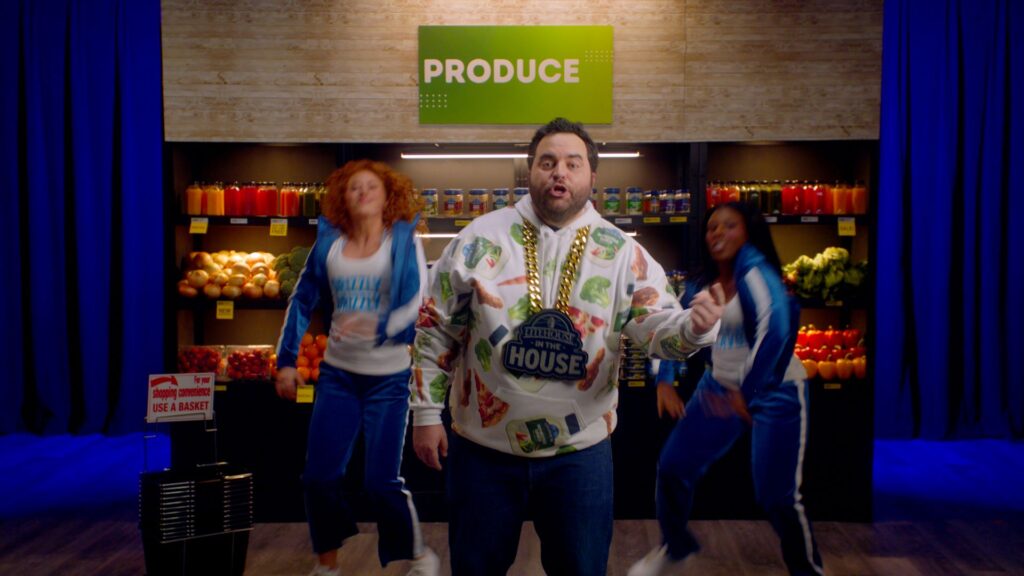
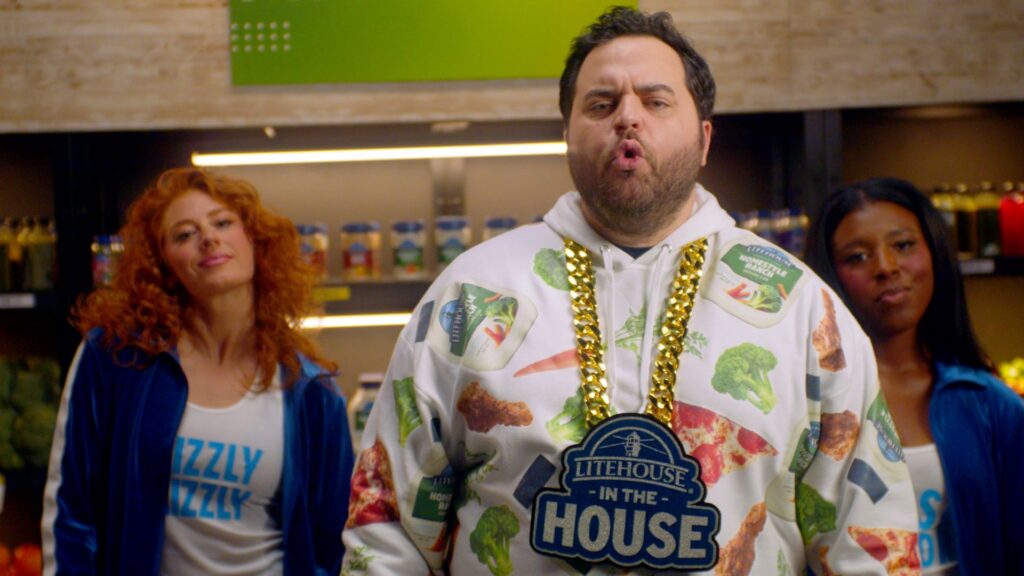
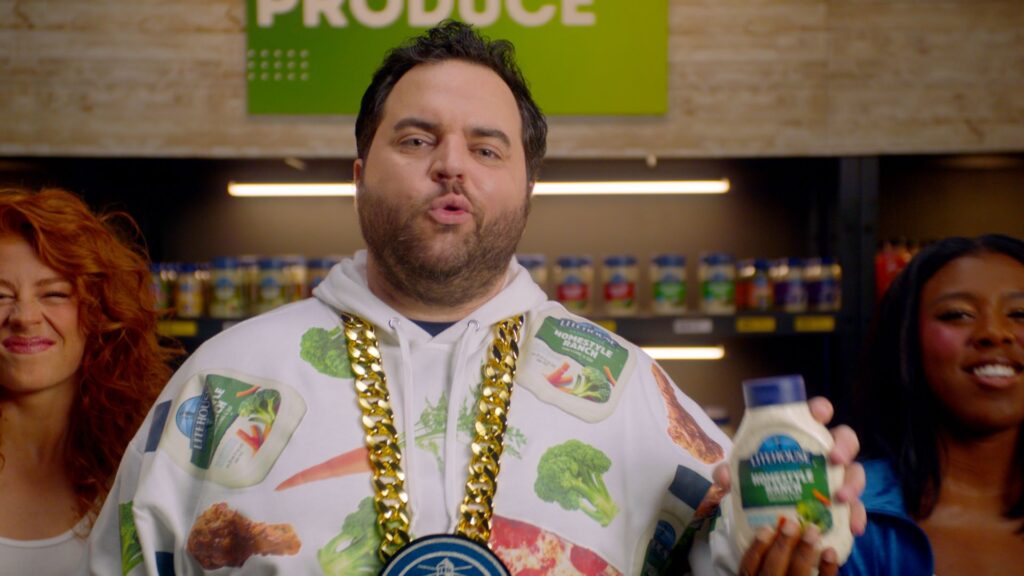
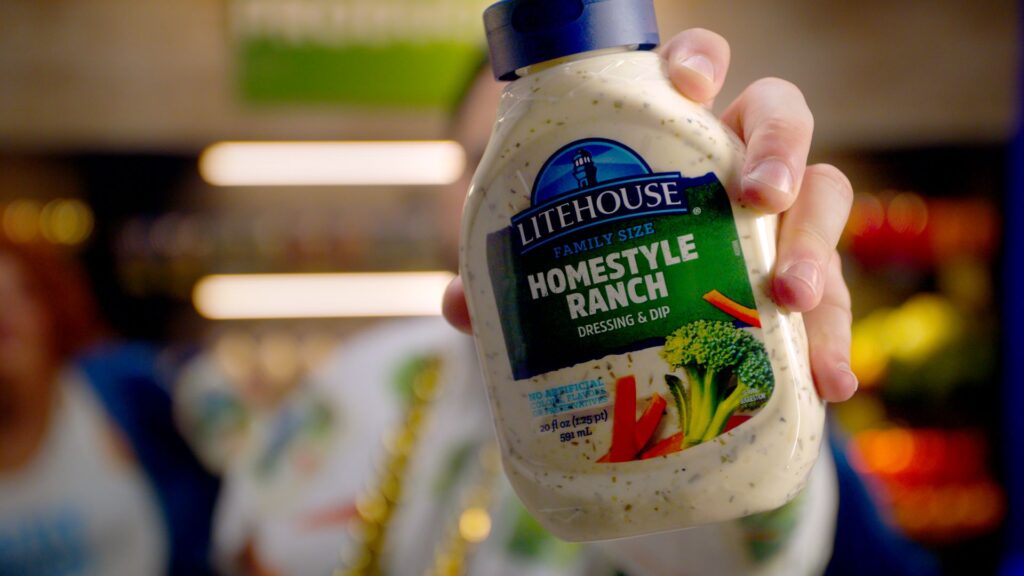
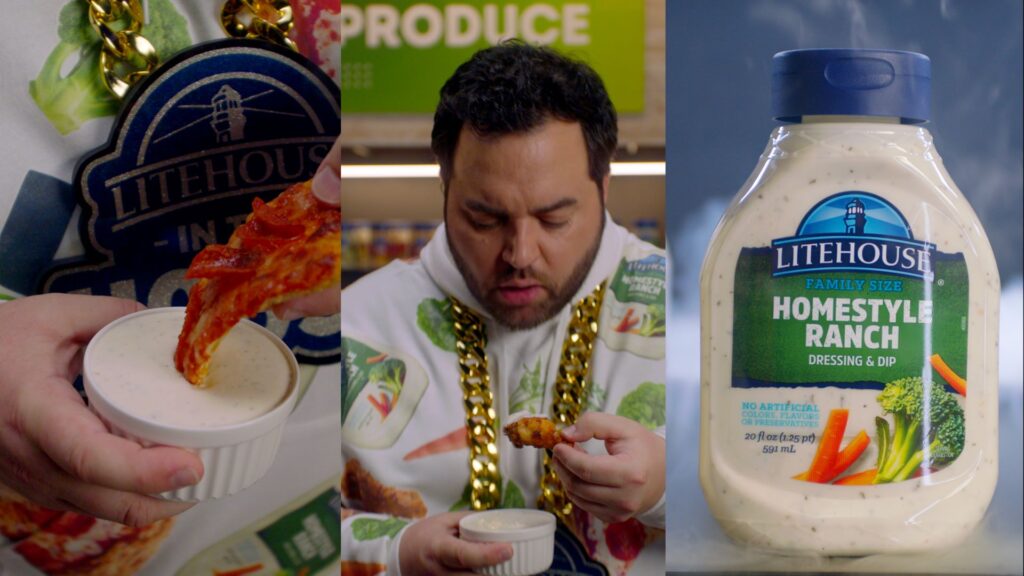
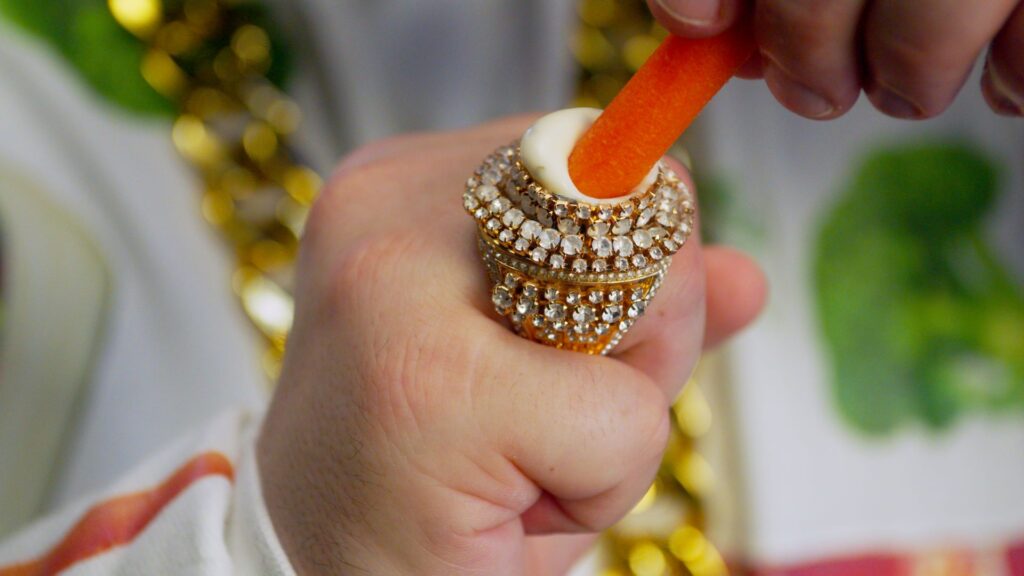
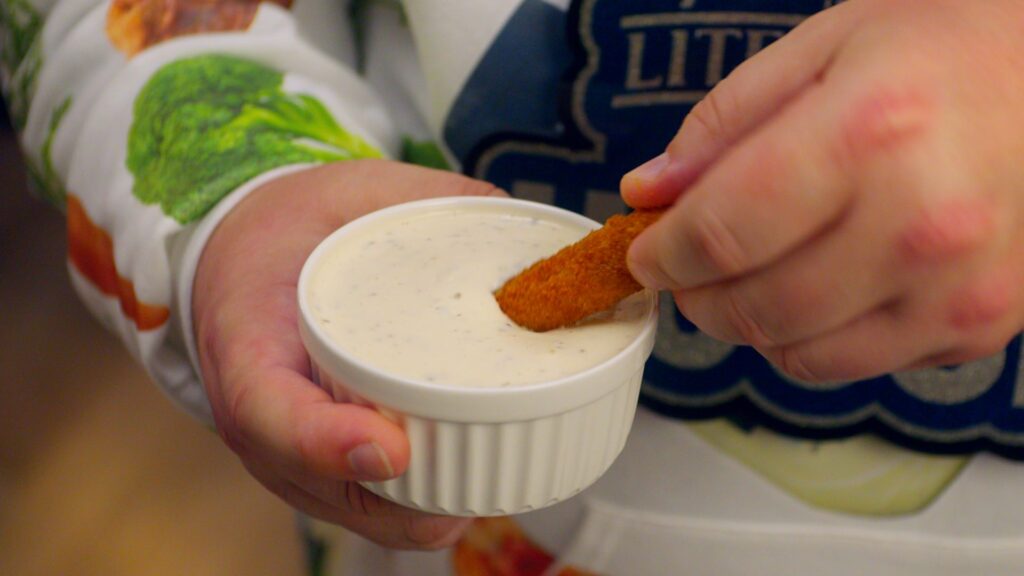
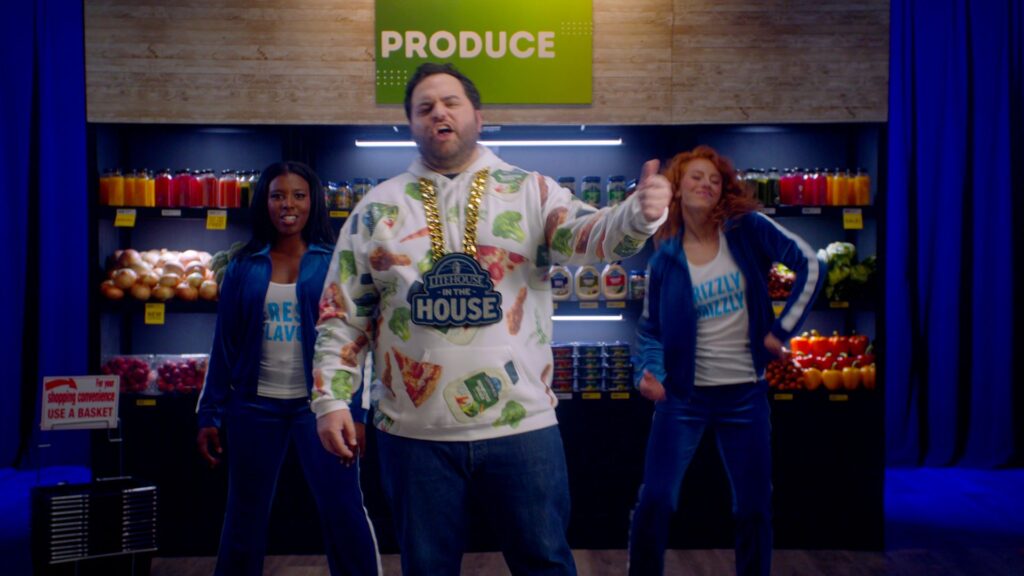
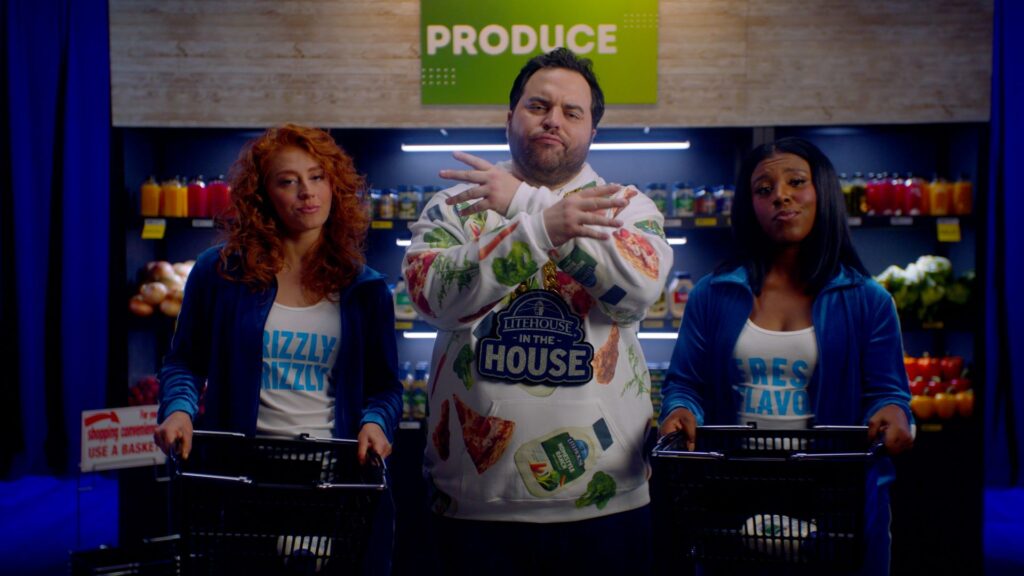
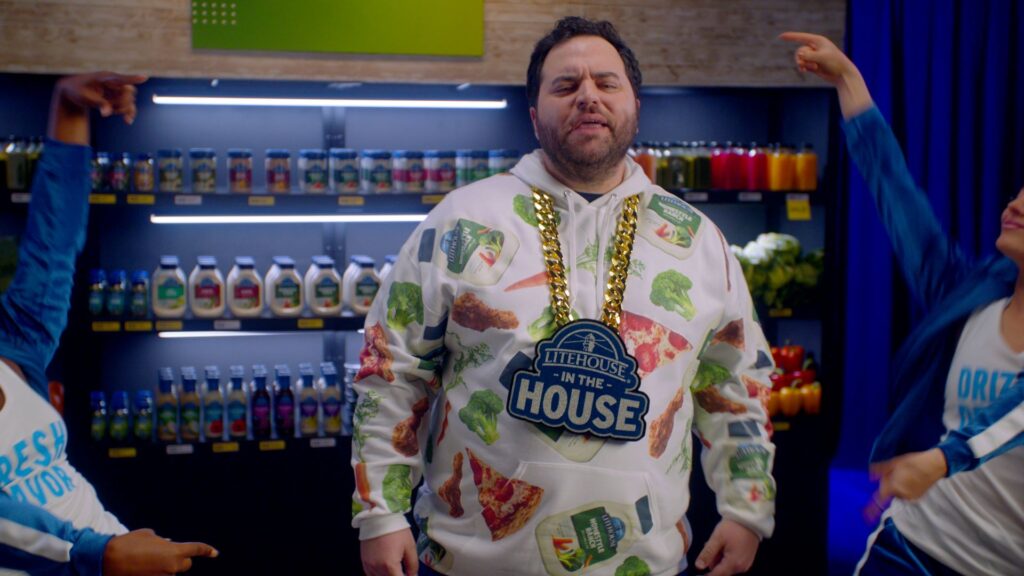
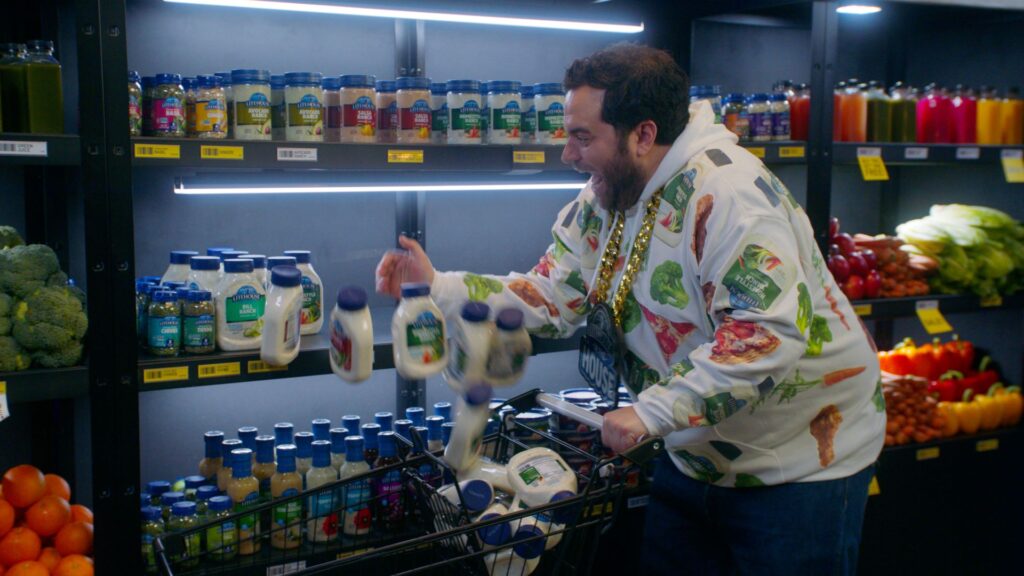
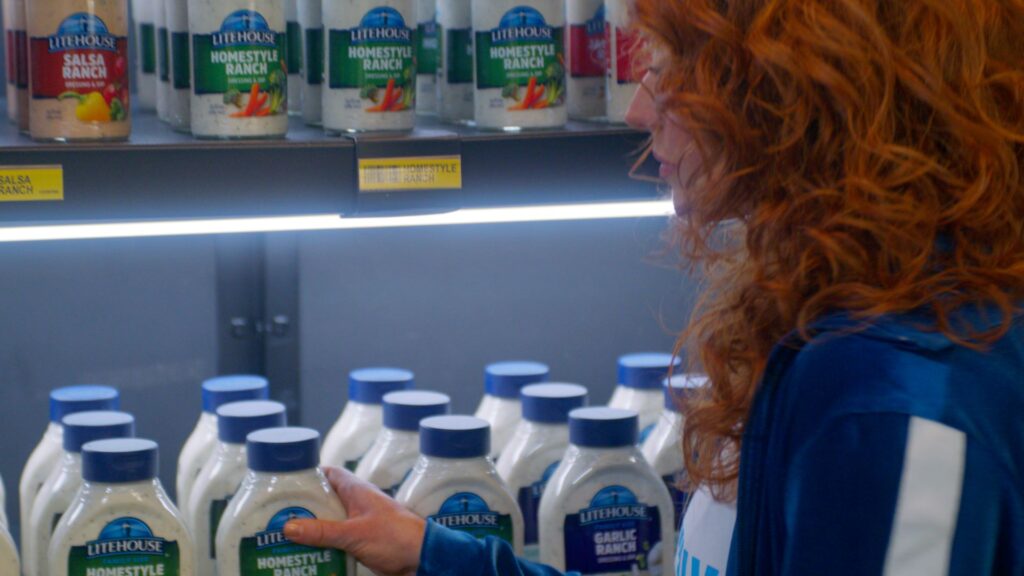
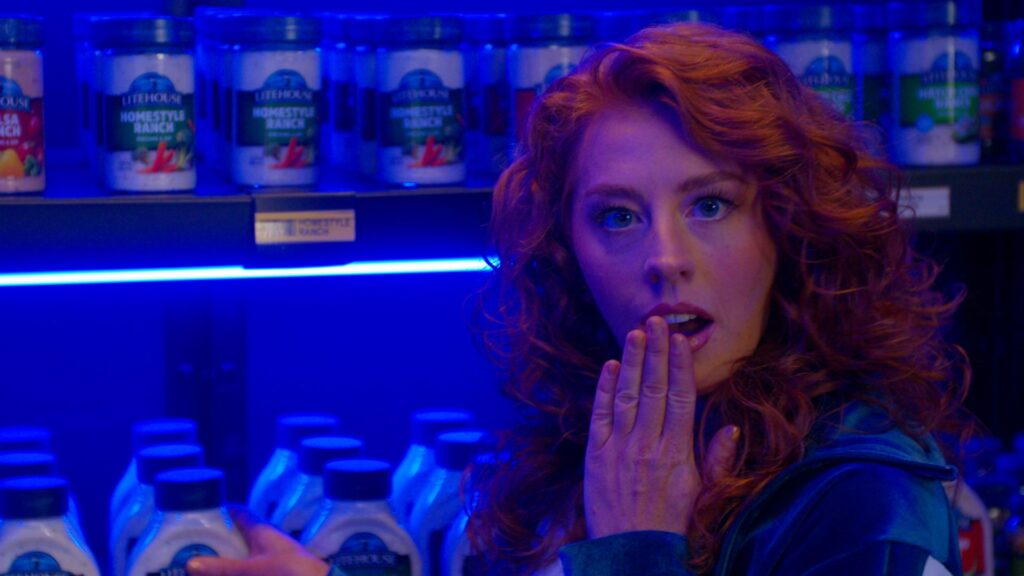
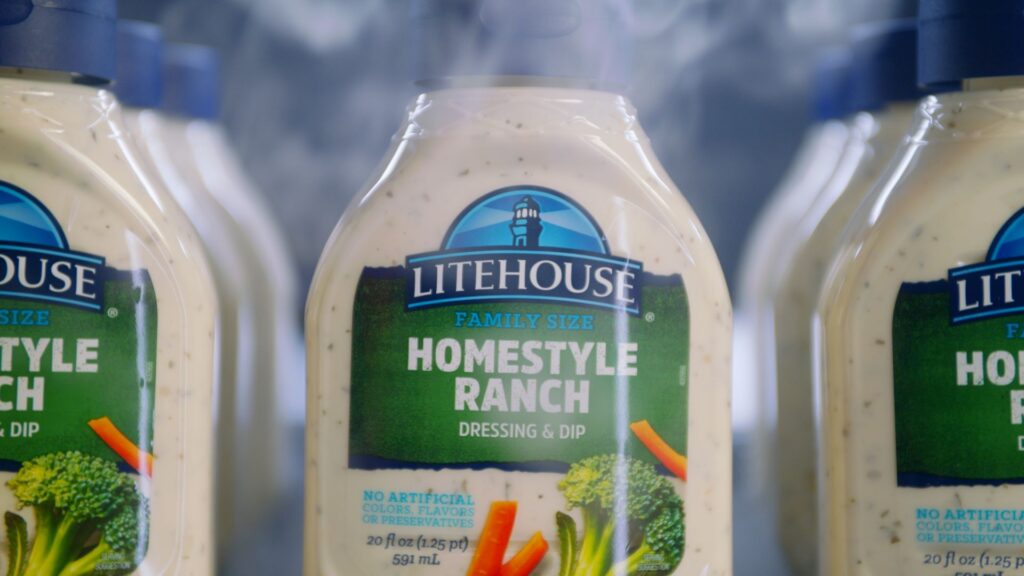
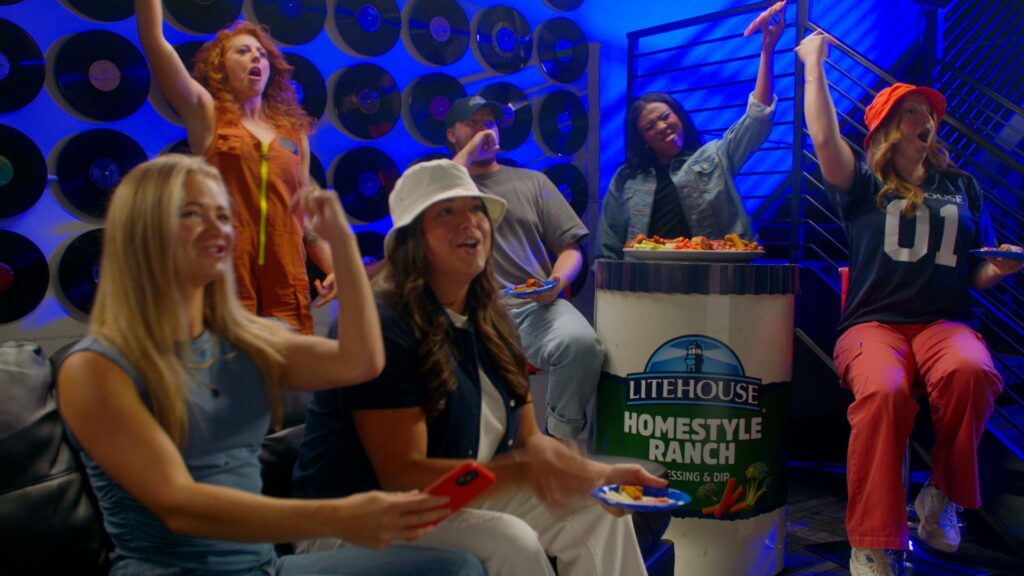
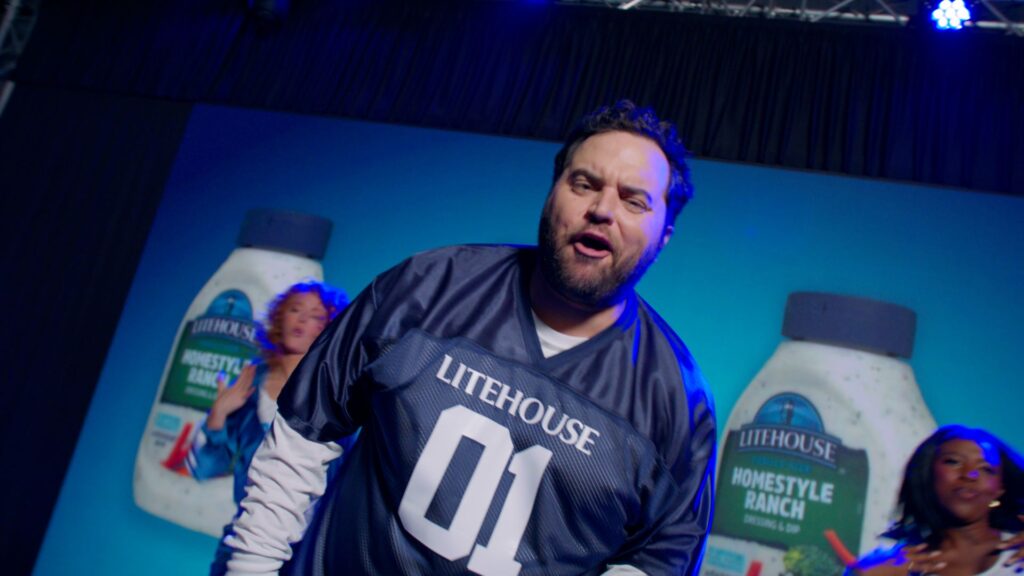
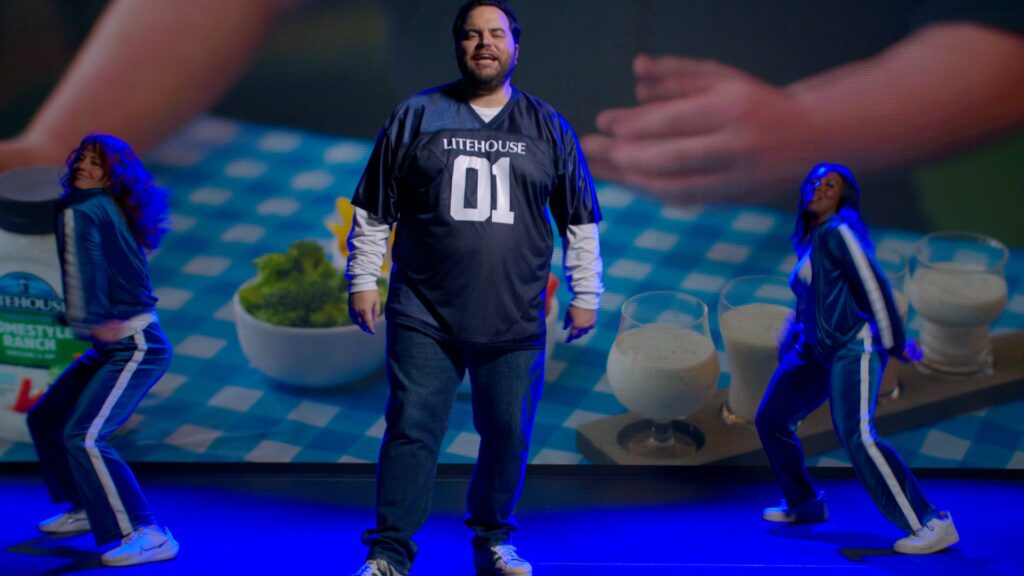
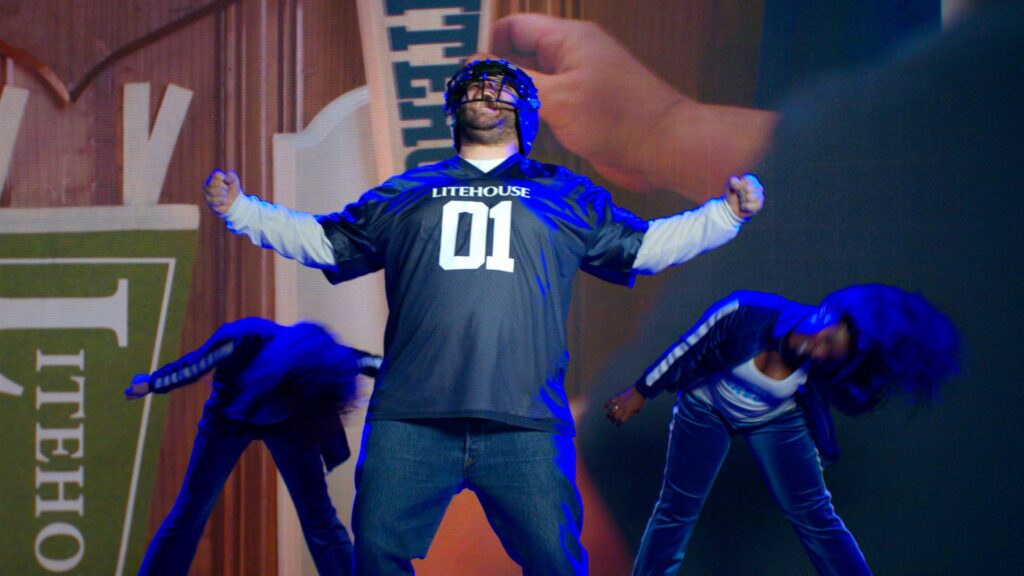
youtube
pre-production
Because he was instrumental in impressing their past clients, Tyler was approached by directors Chad Neidt and Woody Roseland to light these two music-video styled commercials for Litehouse Foods.
This project would be given the following constraints:
- Two set days – one pre-light day and one filming day
- One studio location with four separate scenes
- All four scenes were to be pre-rigged to minimize downtime during the filming day
- There would be enough budget for an additional grip package beyond Tyler’s 1-ton van
To optimize available time during the pre-light day, Tyler first spent an hour with DP Justin Balog reviewing storyboards, building an equipment list, and creating lighting diagrams.
Tyler and the DP settled on the following lighting package:
- Aputure 1200d Pro – 1200W daylight-balanced point source
- (3) Aputure 600d Pro’s – 600W daylight-balanced point source
- (2) Kelvin EPOS 300’s – 300W RGB-capable point source
- (8) Aputure Infinibar PB12’s – 4′ RGB-capable linear LED
- (2) Aputure Infinibar PB6’s – 2′ RGB-capable linear LED
- (8) Aputure MC Pro’s – RGB-capable mini-LED
- Intellytech Mega-Litecloth – 5×3′ bi-color panel
- Amaran F22c – 2×2′ RGB-capable panel
This package was chosen because every light has DMX control built into it, making controlling all four individual sets a breeze. Having all of the practical lights, the Infinibars and MC Pros, be from the same brand also meant there wouldn’t need to be any fine-tuning to get them all to match in perceived output.
Lights were controlled wirelessly via CRMX protocol with Blackout Lighting Console and a Lumenradio Aurora transmitter. This wireless control setup enabled quick swapping between the different looks for both songs, as well as increased Tyler’s set efficiency.
To enable all 4 scenes to be rigged during the pre-light day, Tyler recruited Eric Fulcher as his key grip, and had him bring his 3-ton grip truck.
This decision was invaluable in minimizing downtime during set day as the amount of hardware between Tyler’s 1-ton G&E van and Eric’s 3-ton grip truck meant the G&E team could pre-rig everything during the pre-light day.
scene one
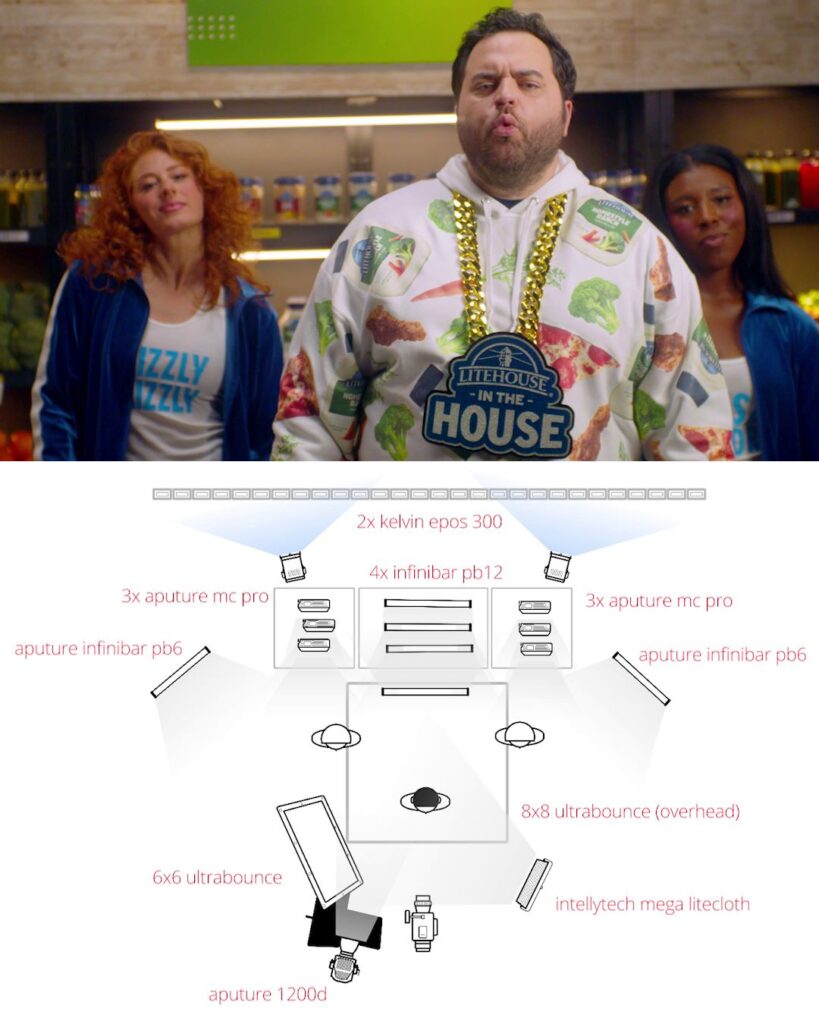
This first scene was easily the most involved out of the three to build and film.
It took place in a simulated grocery aisle that had to be built from scratch. So, after the art department team built out the produce aisle, it was time for G&E to get to work.
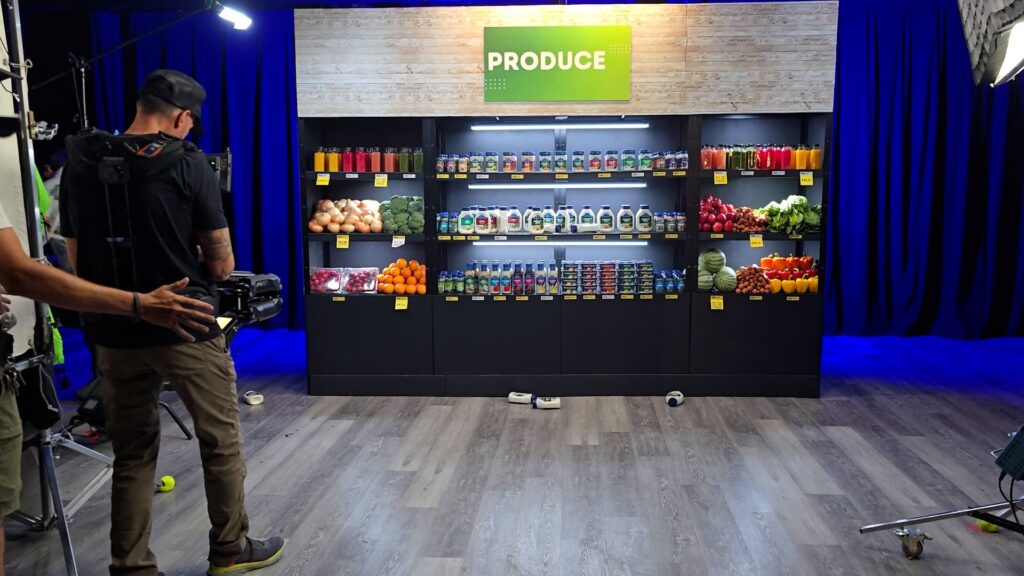
First, the team knew the lead talent was blocked into an area about ten feet in front of the produce shelves, and that he’d be moving around in a 3-foot diameter area during the master performance take. He’d also have a dancer on either side of him and slightly behind.
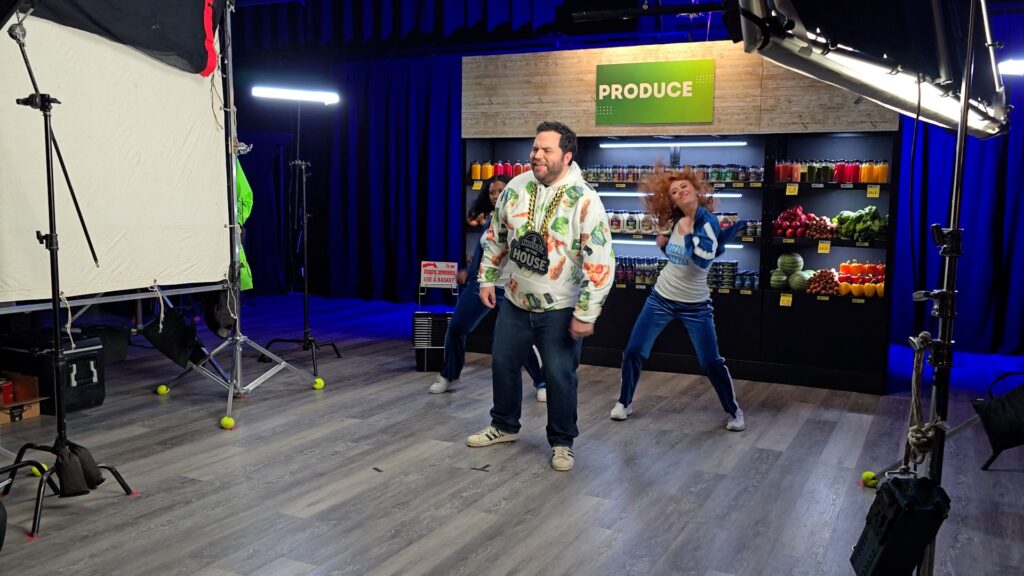
The DP, Justin Balog, had communicated in his pre-production coffee chat with Tyler that he’d like a soft key light that could be relatively movable and controllable. Meeting both of these conditions would make it easy to get the dozen-plus shots that were needed on filming day.
The Intellytech Mega Litecloth on a roller combo stand ended up being the perfect light to use as the key. At 5 feet by 3 feet, the Mega was wide enough to be flattering to the talent, and by placing it on rollers, it was easy to position this light wherever necessary in-between takes.
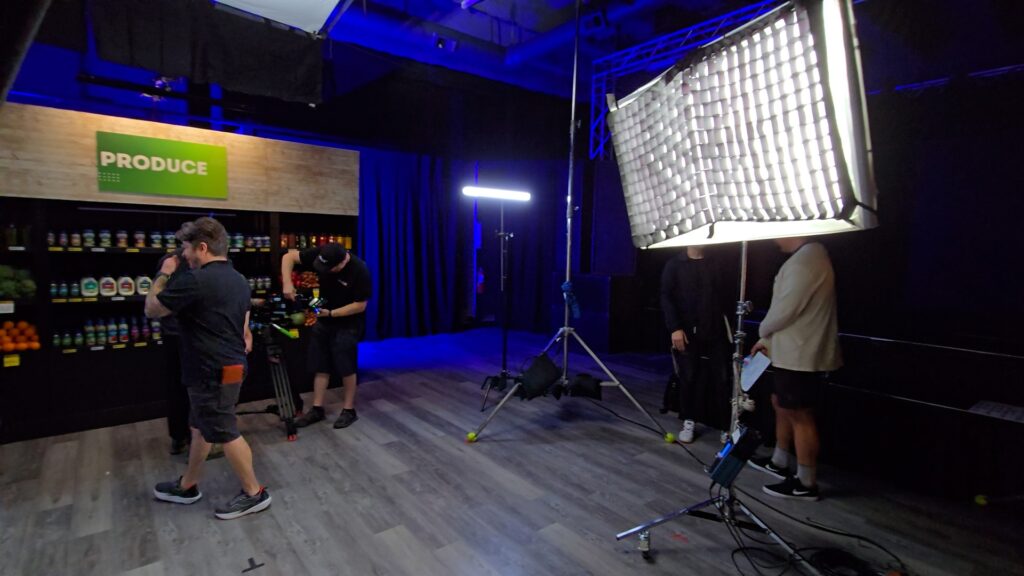
The light also comes with a grid, which was used to control how much the beam spreads out and made it easier to feather.
Feathering is a technique where a light, usually with a grid, is rotated lamp left/right until it affects only the subject it’s meant to be illuminating and not anything else in frame.
By combining a grid with feathering, Tyler was able to illuminate the subject while keeping the Mega from affecting the intensity of the produce shelving in the background.
Without this level of control, the key light would have increased the brightness level of the background of the scene, and potentially even added reflective glare spots since the shelving was metal.
Regardless of where the talent was positioned relative to the set during the take, the key light was positioned off camera right, and kept between frontal and Rembrandt.
Next, the team needed to increase the intensity of the shadow side of the lead talent’s face so that it was closer to a standard commercial ratio of 2:1.
To accomplish this, a 6×6 frame with an ultrabounce rag was positioned camera left. The size allowed G&E to easily reposition it during takes as necessary, as well as still be large enough to cover a wide space for the talent to move around in.
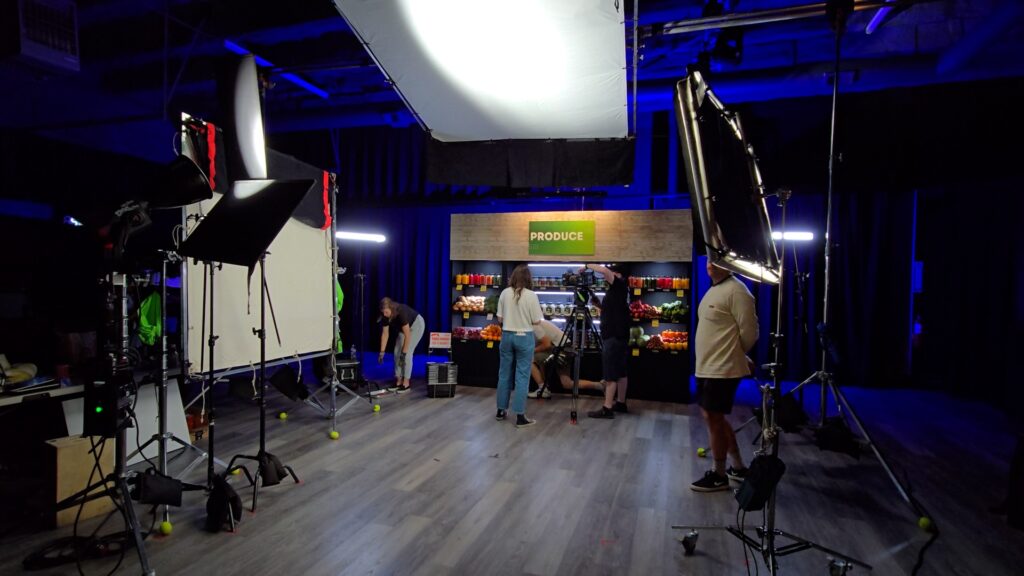
To both pop the subject from the grocery shelving, and give general “room fill” to the area where talent would be acting, an Aputure 1200d Pro with narrow reflector was pushed into an overhead 8×8 ultrabounce.
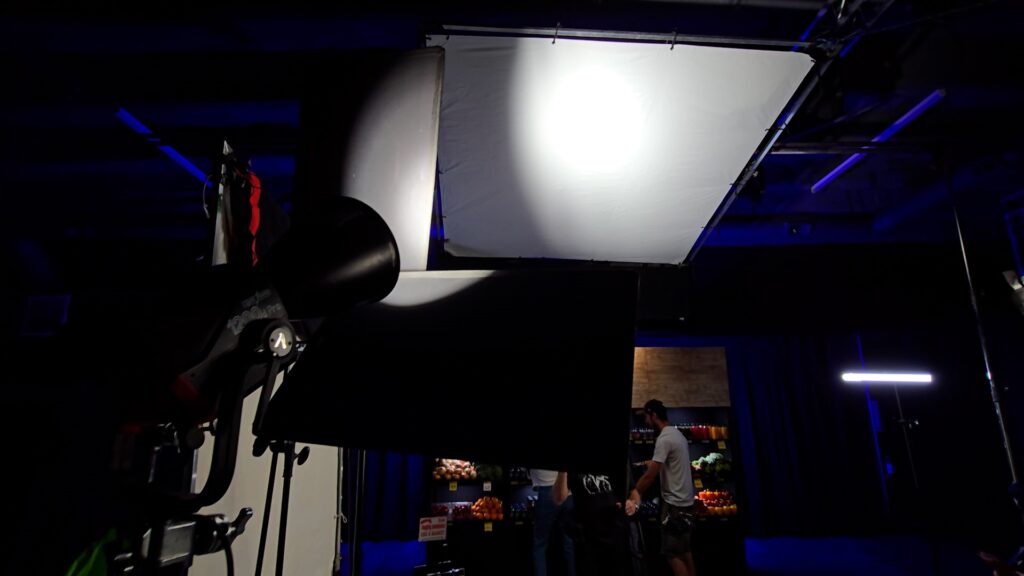
To get the 8×8 in place, the key grip built out a double-stacked speed rail rig using four 12′ pipes that spread across the set. This was supported by two mombo combos.
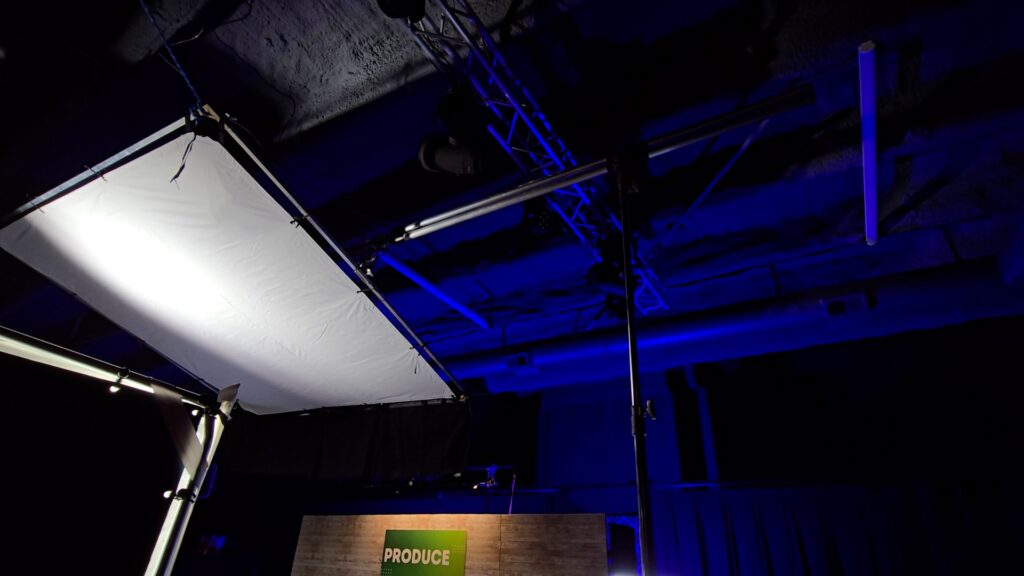
The 8×8 frame was then rigged to that speed rail setup, safety-chained, and then tied off to a couple rigging points inside the studio for additional safety.
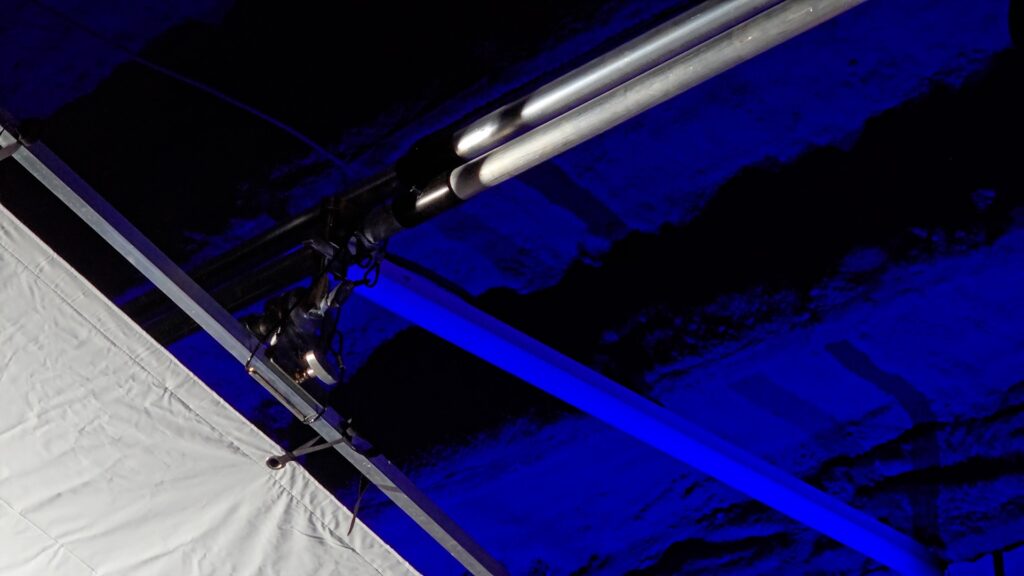
The 8×8 frame was angled slightly to help return the light from the Aputure 1200d Pro back towards the set rather than skip towards the back of the room. The frame had a duvetyne skirt hanging off the back of it to further help kill the rear spill.
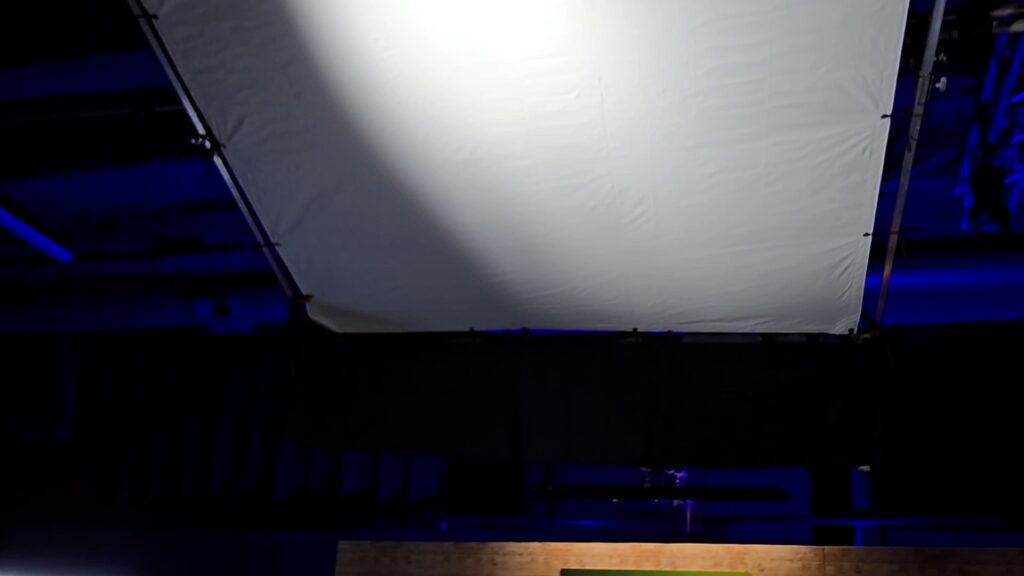
To keep the Aputure 1200d Pro from spilling directly into the set, a 2×3′ flag was placed horizontally in front of the light.
A second flag was placed to cut the left side of the light, evening out the exposure of the produce shelving in the back of the frame to be within 1/3 of a stop across it’s entire width.

To light the shelving of the “produce aisle”, three Aputure Infinibar PB12’s were placed in the center shelving unit, and 6 Aputure MC Pros, 3 to a side, lit the two shelving units offset to each side.
Because these all have built-in magnets on the back, they easily stayed in place on the magnetic shelving unit.

The sign above was lit by a fourth Aputure Infinibar PB12, which was boomed in from behind the shelving.
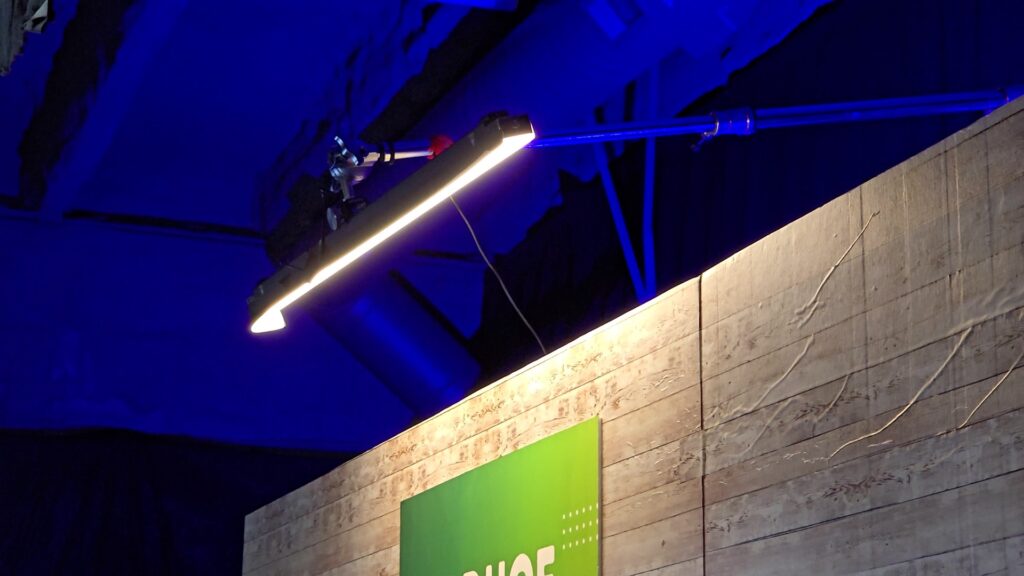
Two Kelvin EPOS 300 units lived behind the “produce aisle” and were set to output the Litehouse Foods brand color in HSI mode onto the curtains.
These lights added some depth behind the scene, giving the steadicam operator room to film beyond the tight-cropped boundary of the produce aisle.
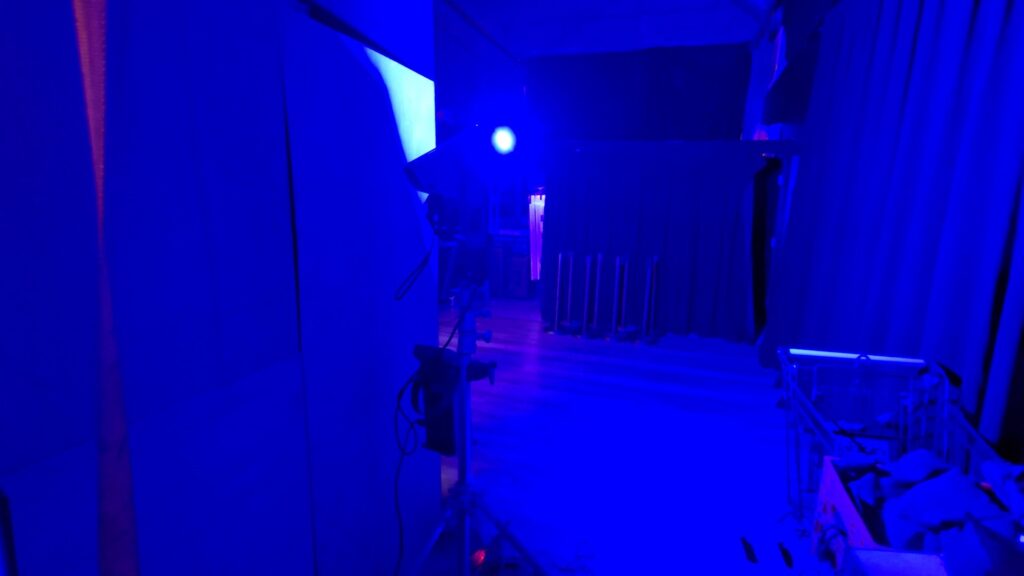
Lastly, two Aputure Infinibar PB6’s were placed on c-stands and set just out of frame behind the dancers.
These helped to provide background separation between them and the produce aisle whenever they appeared in frame.
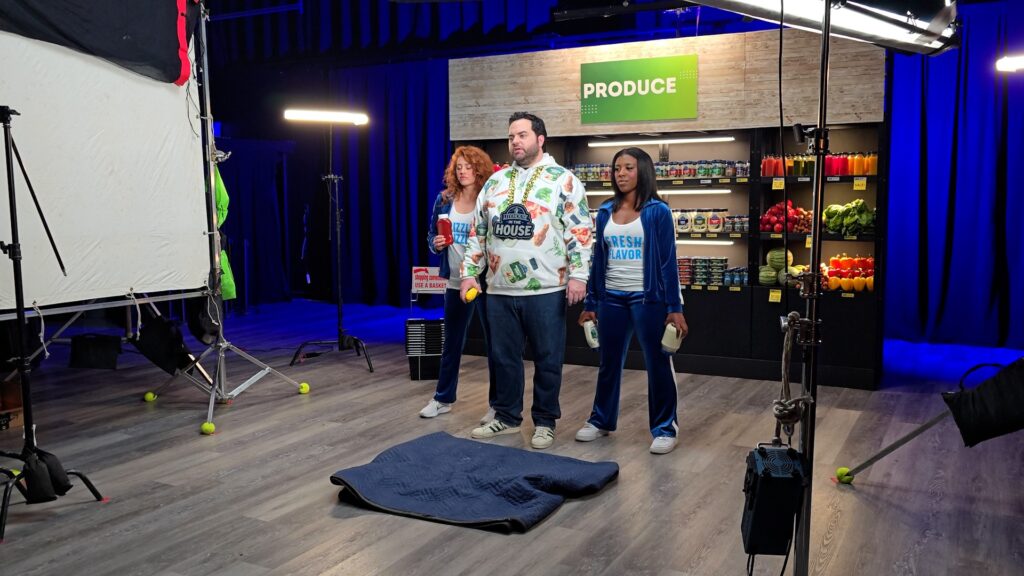
To make it easier to record all the takes required for each of the two songs in one day, all the lights in this scene were controlled via Blackout Lighting Console with Tyler’s Lumenradio Aurora CRMX transmitter.
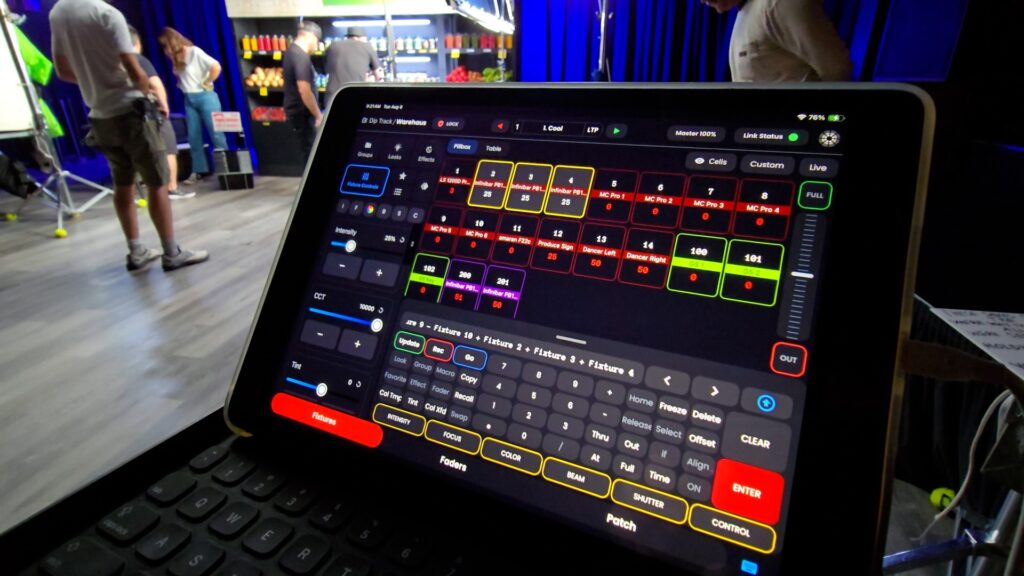
He was able to save all of the lighting for each song as a separate look within Blackout. This allowed him to re-light instantly whenever the take called for it.
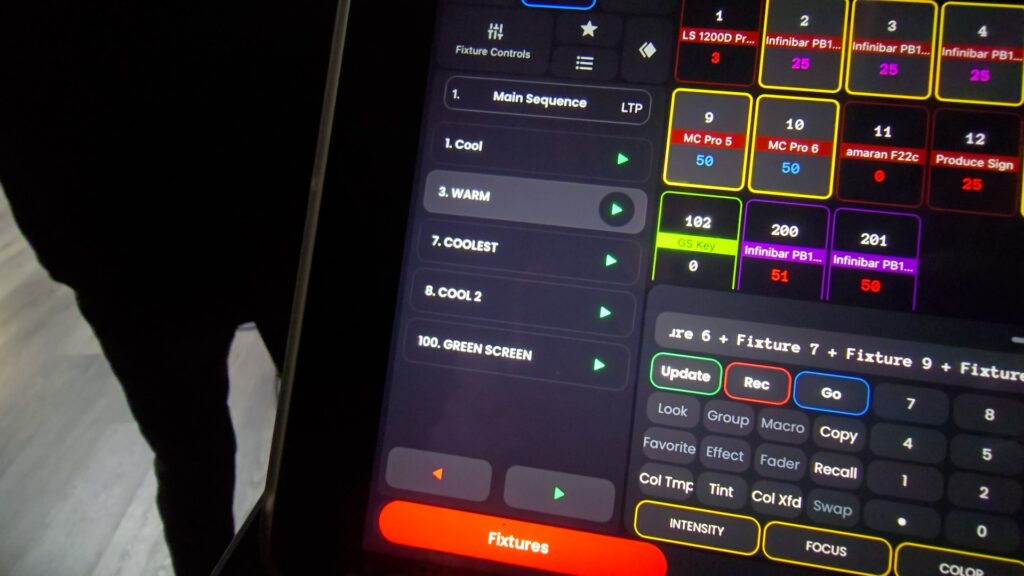
And as a result of having everything on CRMX control, Tyler was also able to program the below DMX cue where the lights go from daylight to blue as an in-camera effect, which was an idea that the client and directors requested during set day.


The produce aisle setup is also where the “smoke” effect insert shot was filmed.
The effect was achieved by slowly adding water to a baking pan filled with dry ice. The resulting evaporate was then gently poured over the rim of the baking pan into the top of frame.
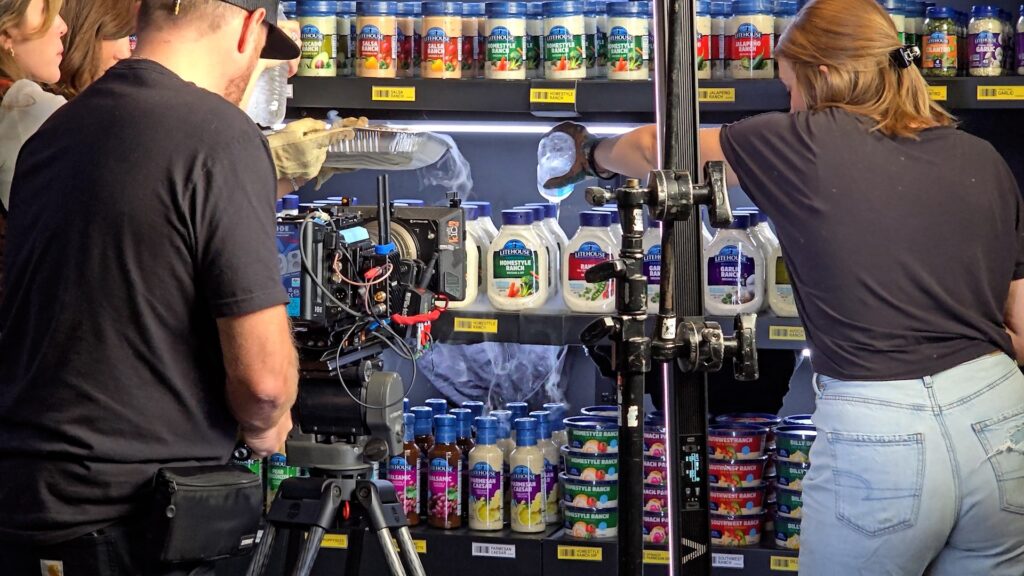
An additional pan was placed behind the bottles to create a similar effect at the bottom of frame.
scene two

The second scene of the day involved mimicking a live performance by filming with a platform stage and LED wall that were built into the location.
For the key light, the team ended up using the amaran F22c.
This was set to TV effect mode because the DP wanted to simulate some of that LED wall behind the talent wrapping around him.
During the pre-light day, Tyler and the DP tested two different key light setups: an Aputure 1200d Pro set to TV effect pushed through an 8×8 magic cloth, and an Amaran f22c set to TV effect with no additional modification.
They concluded that despite the smaller surface area, the amaran f22c setup provided a more convincing TV effect than the 1200d because of it’s ability to vary CCT. Also, a slightly harsher shadow matches a live performance and can be accounted for with blocking, so Justin and Tyler were more inclined to see this trade-off as favorable.
Another consideration for which key light setup to choose was how much time the camera team would need on the day of filming. Because of the amount of requisite coverage, production made it clear that G&E was to work efficiently to maximize the time spent filming.
Using the amaran f22c as the key instead of the Aputure 1200d Pro would also mean that G&E could be reset in less than 5 minutes between the first and second scenes, as only the shadow fill would need to be re-positioned.
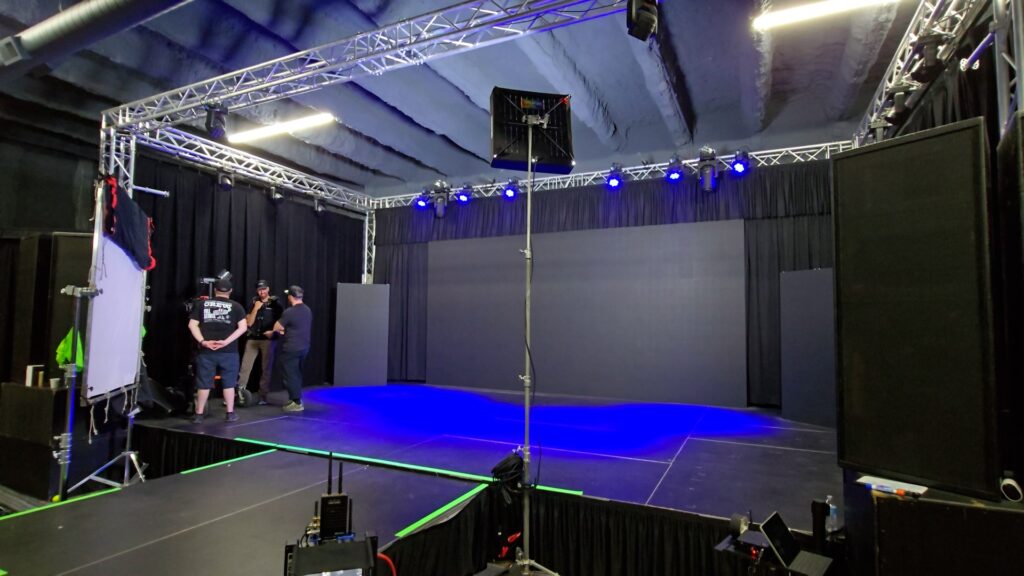
The same 6×6 ultrabounce from scene one was used as shadow fill for scene two. The ultrabounce was used rather than another light so that it could return some of the light quality from both the LED wall and the amaran F22c.
Doing this gave some character to the fill, blending it into the scene better than than if the fill had been from a third light.
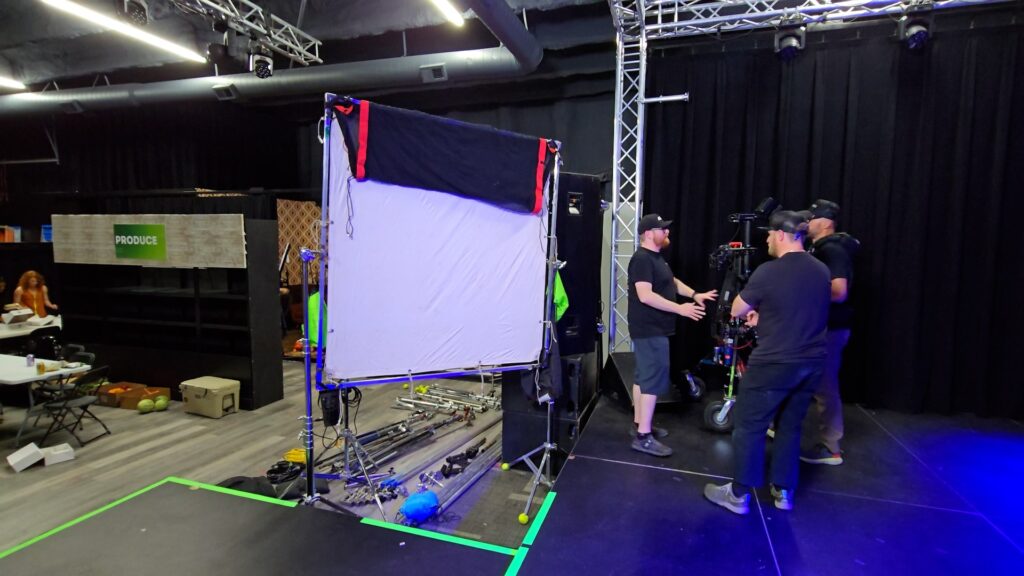
To decrease downtime during film day, the team spoke with location during the pre-light day and arranged the use of the installed location lighting to create separation and add the blue background edge to the talent. These lights are also occasionally seen in frame as practicals that help sell the stage setting.

scene three

The last scene barely appears at all in either commercial, but took the most amount of collaboration between camera and G&E to achieve.
Tyler and the DP knew Litehouse Foods wanted to film in this confined corner of the studio because the client wanted to have a record-label look somewhere in the commercial segment.
But shooting directly into the corner, and against the wall like this was going to be pretty tricky to make look as cinematic as the rest of the commercial.
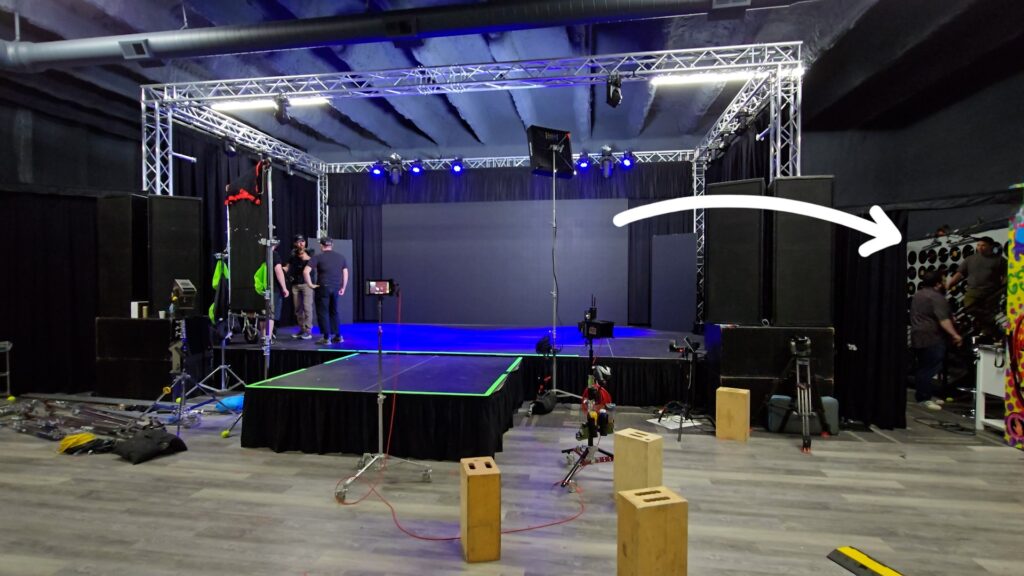
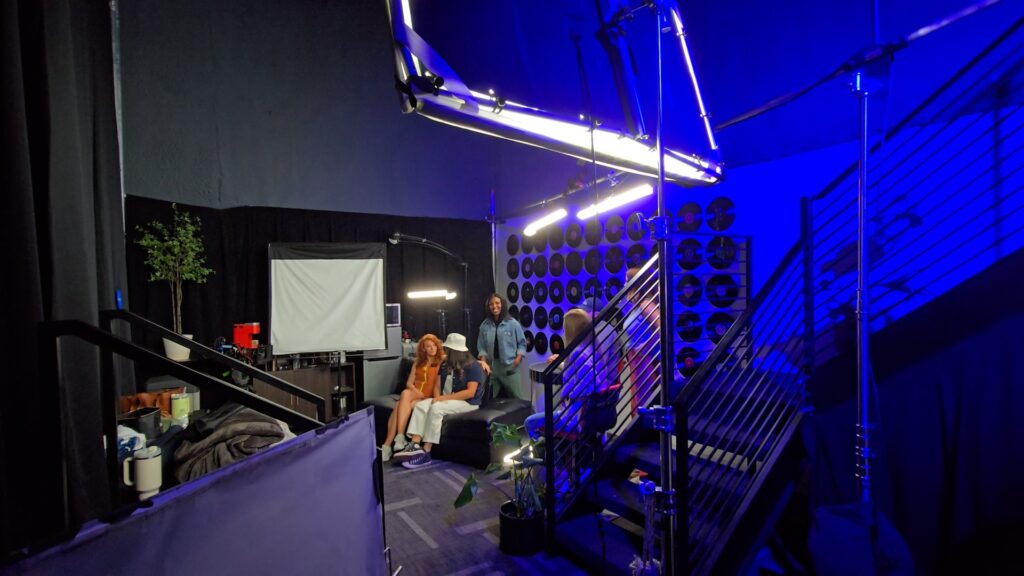
To help block the scene, the team moved the couch away from the wall, and re-located the Litehouse Ranch bar table to the corner near the stairs.
Moving the couch away from the wall and framing into the “corner” like that helped reduce the flatness of the image. The area behind the stairs also has a more depth to it and is more visually interesting than if the team shot into the actual corner of the space containing the black curtain.
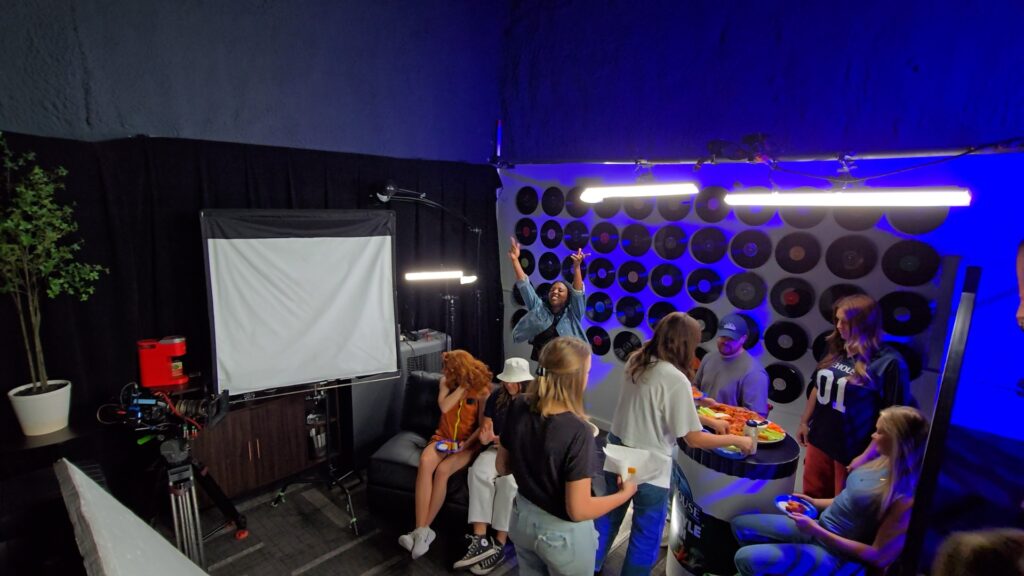
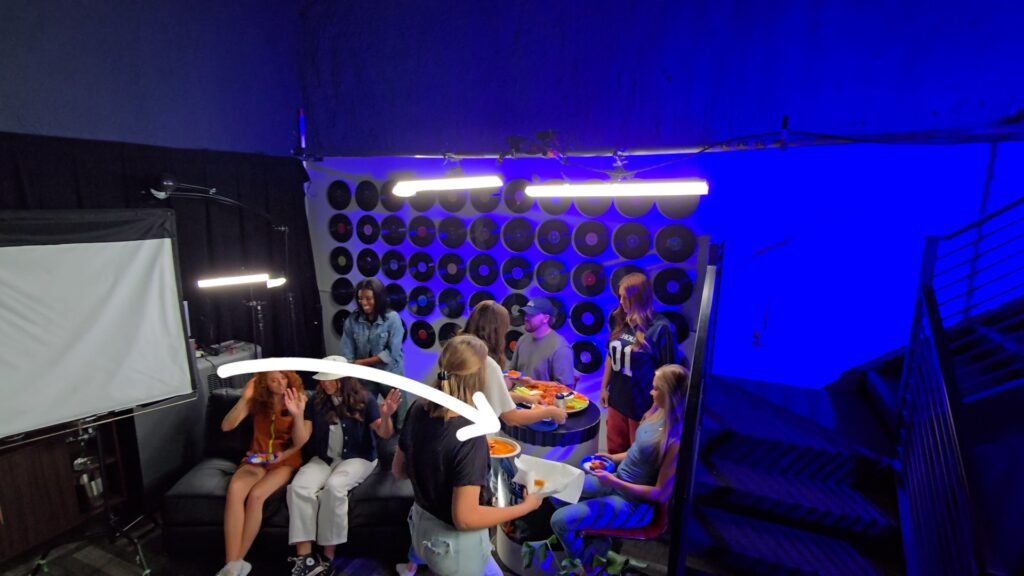
Once the scene was blocked and the camera framing was established, it was time to start lighting.
If the key light was pushed directly from camera right into the opposite wall, the talent on the couch and the wall behind them would be approximately the same intensity, which would end up with a scene lacking in visual depth.
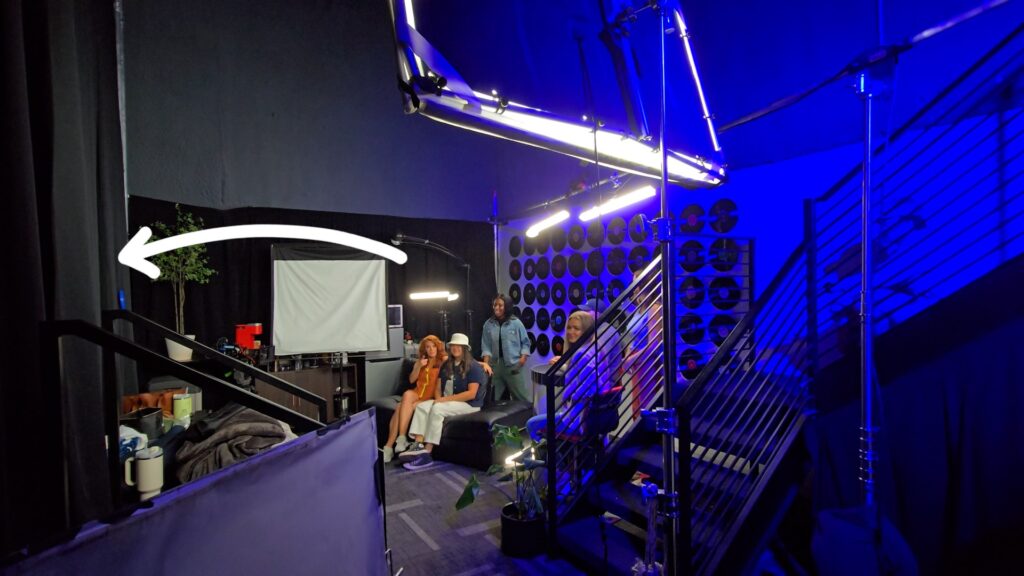
Having the key come from this direction would also have pushed light frontally into the talent’s faces, giving them a flat look.
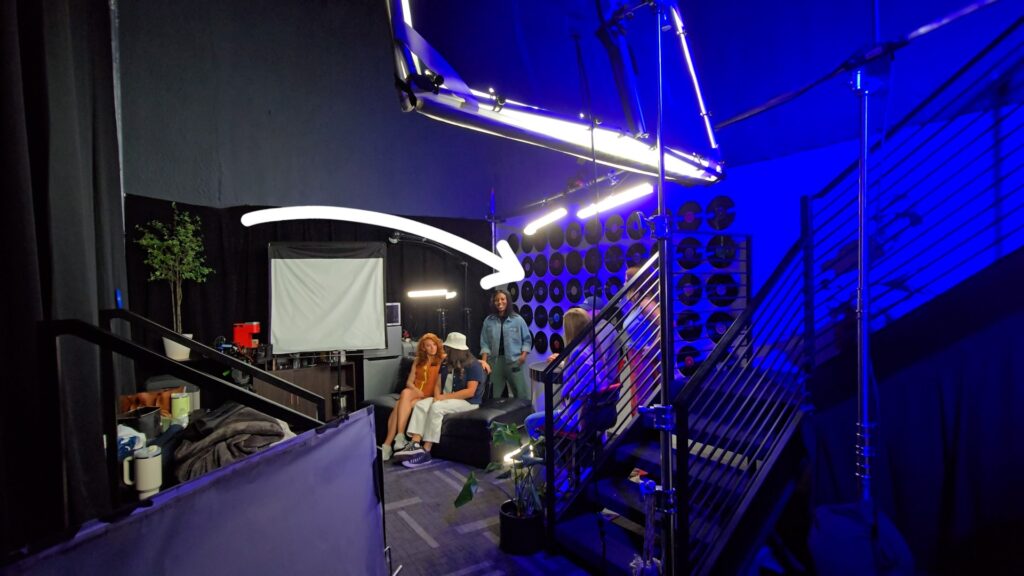
To resolve both of these issues, Tyler moved the key light into a far-side key position, much further back in the space.
The Intellytech Mega-litecloth ended up working perfectly here, as it’s 5×3′ size gives a soft look in a compact form factor that made the most of the space limitations.
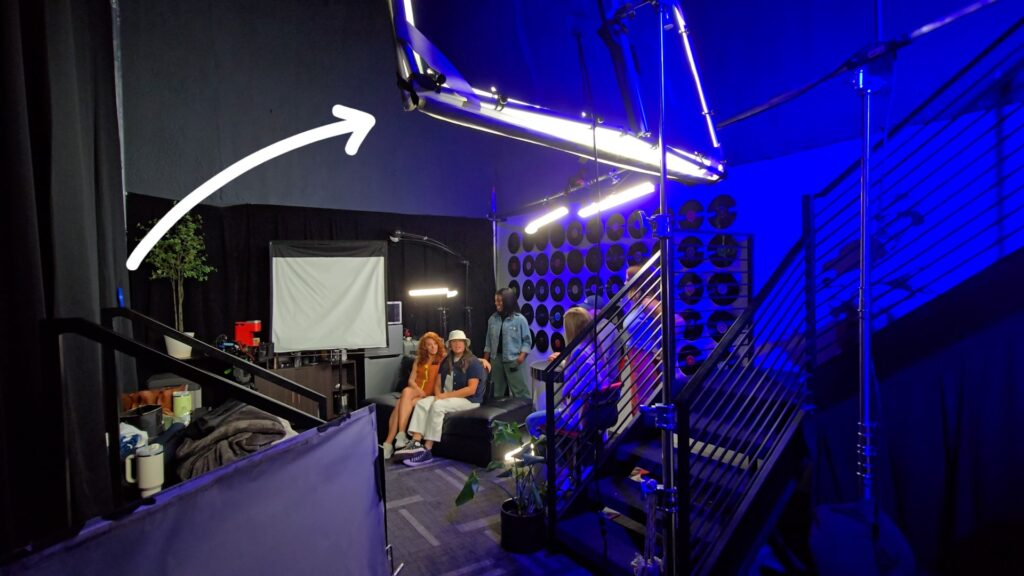
This had a grid placed on it to help control the spill from affecting the background wall.
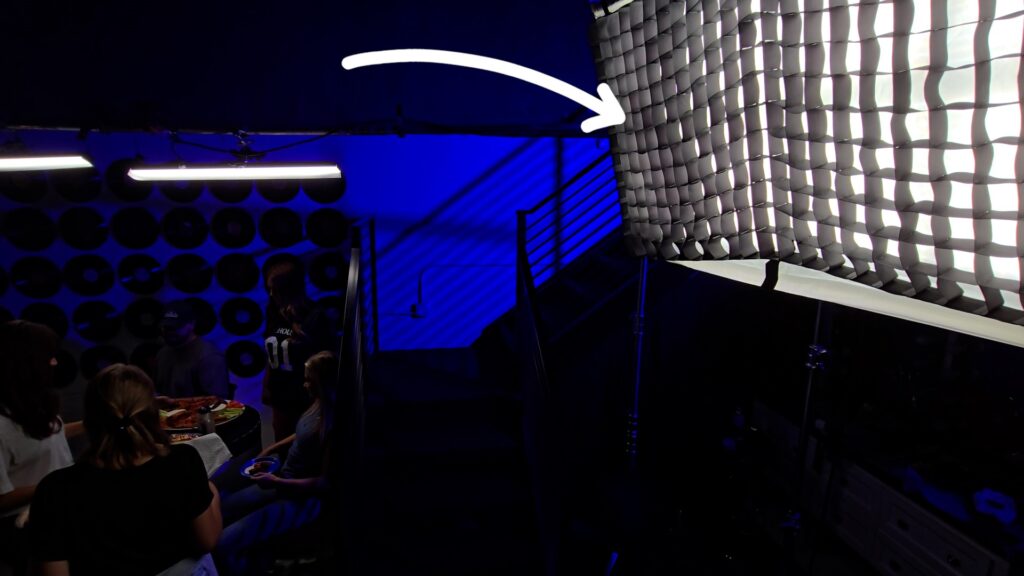
Next, two bounces were placed to help fill the shadow areas of the foreground talent sitting on the couch.
A 4×4 ultrabounce landed just camera left to fill in the shadow side, and a 4×4 beadboard helps lift the area under the chin.
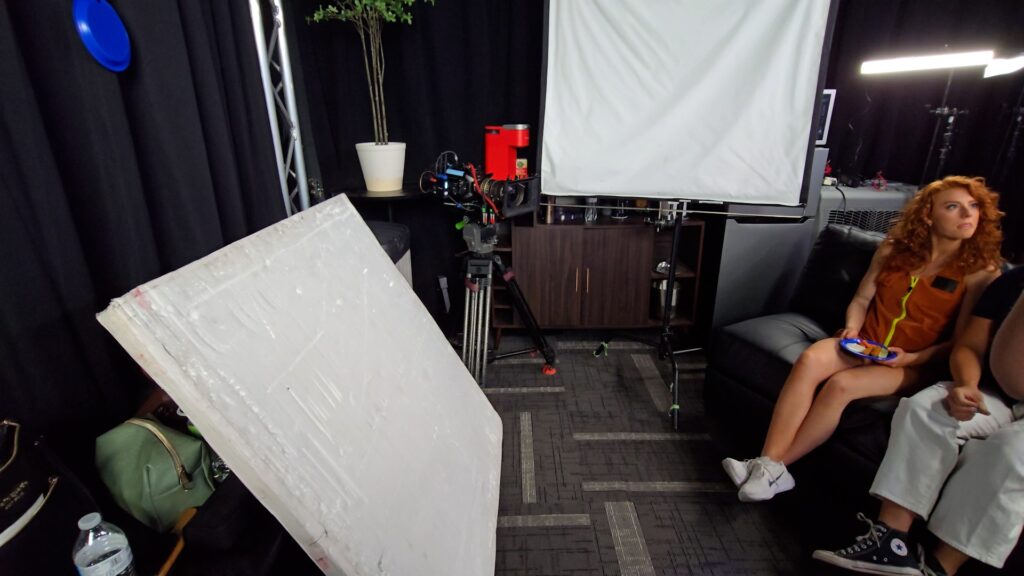
To provide separation from the wall for the talent on the couch, as well as an overhead “key” for the talent around the back table, the key grip built an overhead speed rail rig that enabled two Aputure Infinibar PB12’s to be suspended over the space.
These bars were gaff-taped on the back, which reduced their spill onto the wall, keeping the blue hue from losing saturation.
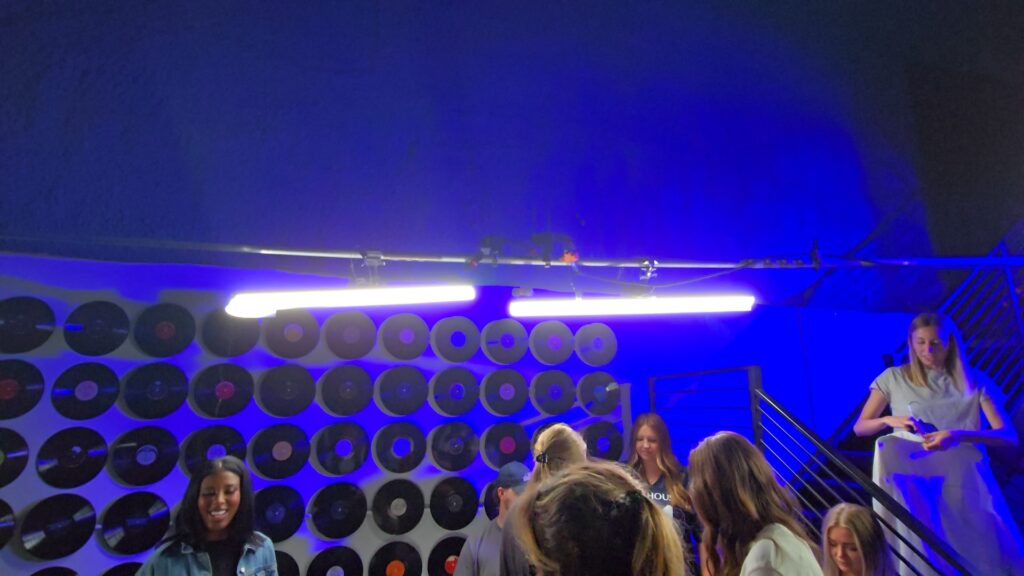
An Aputure Infinibar PB6 was placed off camera left to help provide additional separation to the talent on the couch in the foreground.
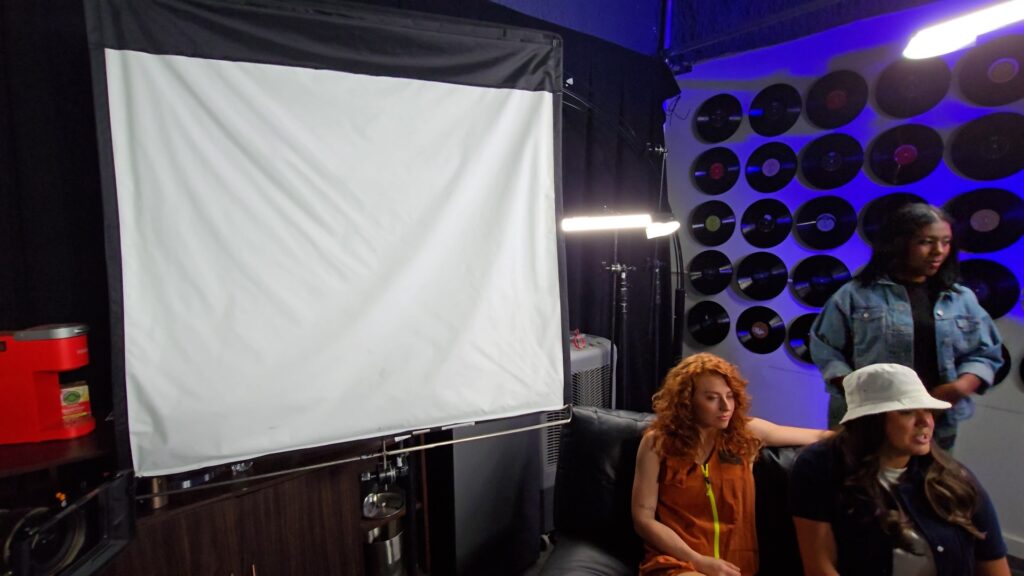
Lastly, two lights help add viewer interest to the scene.
A second Aputure Infinibar PB6 just under the couch is adding a splash of light to the Litehouse Ranch logo on the bar table, and a Kelvin EPOS 300 casts a brand-specific blue hue over the back wall, adding color contrast to the warmer hues.
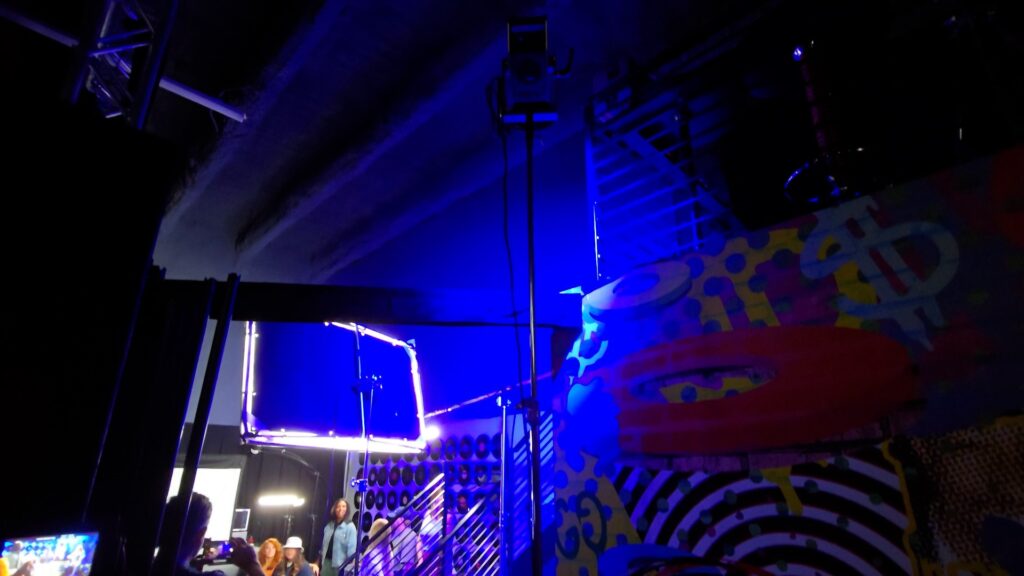
conclusion
With a relatively unconstrained budget but a tight filming timeline, Tyler assembled an efficient G&E package and team that enabled directors Chad Neidt and Woody Roseland to go above and beyond in satisfying their client’s wishes.
If you’ve got a project, please use the contact button below!
Tyler’s collaborative mindset and experience as an on-location commercial specialist combine to make him an invaluable addition to any film set in the front range area!
